+ Open data
Open data
- Basic information
Basic information
| Entry | Database: PDB / ID: 7zbz | |||||||||||||||||||||||||||||||||||||||||||||||||||||||||||||||||||||||||||||||||
|---|---|---|---|---|---|---|---|---|---|---|---|---|---|---|---|---|---|---|---|---|---|---|---|---|---|---|---|---|---|---|---|---|---|---|---|---|---|---|---|---|---|---|---|---|---|---|---|---|---|---|---|---|---|---|---|---|---|---|---|---|---|---|---|---|---|---|---|---|---|---|---|---|---|---|---|---|---|---|---|---|---|---|
| Title | CAND1 delhairpin-SCF-SKP2 CAND1 partly engaged SCF partly rocked | |||||||||||||||||||||||||||||||||||||||||||||||||||||||||||||||||||||||||||||||||
 Components Components |
| |||||||||||||||||||||||||||||||||||||||||||||||||||||||||||||||||||||||||||||||||
 Keywords Keywords | LIGASE / cullin-RING E3 ubiquitin ligase / SCF / CAND1 / Assembly factor | |||||||||||||||||||||||||||||||||||||||||||||||||||||||||||||||||||||||||||||||||
| Function / homology |  Function and homology information Function and homology informationSCF complex assembly / positive regulation of protein polyubiquitination / Parkin-FBXW7-Cul1 ubiquitin ligase complex / negative regulation of catalytic activity / F-box domain binding / cellular response to cell-matrix adhesion / Aberrant regulation of mitotic exit in cancer due to RB1 defects / PcG protein complex / cullin-RING-type E3 NEDD8 transferase / cullin-RING ubiquitin ligase complex ...SCF complex assembly / positive regulation of protein polyubiquitination / Parkin-FBXW7-Cul1 ubiquitin ligase complex / negative regulation of catalytic activity / F-box domain binding / cellular response to cell-matrix adhesion / Aberrant regulation of mitotic exit in cancer due to RB1 defects / PcG protein complex / cullin-RING-type E3 NEDD8 transferase / cullin-RING ubiquitin ligase complex / positive regulation of ubiquitin protein ligase activity / Cul7-RING ubiquitin ligase complex / ubiquitin-dependent protein catabolic process via the C-end degron rule pathway / maintenance of protein location in nucleus / Loss of Function of FBXW7 in Cancer and NOTCH1 Signaling / positive regulation of protein autoubiquitination / RNA polymerase II transcription initiation surveillance / protein neddylation / NEDD8 ligase activity / negative regulation of response to oxidative stress / Cul5-RING ubiquitin ligase complex / SCF ubiquitin ligase complex / negative regulation of type I interferon production / ubiquitin-ubiquitin ligase activity / SCF-dependent proteasomal ubiquitin-dependent protein catabolic process / Cul2-RING ubiquitin ligase complex / positive regulation of intracellular estrogen receptor signaling pathway / Cul3-RING ubiquitin ligase complex / Cul4A-RING E3 ubiquitin ligase complex / Prolactin receptor signaling / Cul4B-RING E3 ubiquitin ligase complex / ubiquitin ligase complex scaffold activity / cullin family protein binding / positive regulation of RNA polymerase II transcription preinitiation complex assembly / protein K63-linked ubiquitination / protein monoubiquitination / ubiquitin ligase complex / ubiquitin-like ligase-substrate adaptor activity / protein K48-linked ubiquitination / positive regulation of double-strand break repair via homologous recombination / Nuclear events stimulated by ALK signaling in cancer / transcription-coupled nucleotide-excision repair / positive regulation of smooth muscle cell proliferation / positive regulation of TORC1 signaling / negative regulation of insulin receptor signaling pathway / intrinsic apoptotic signaling pathway / TBP-class protein binding / molecular function activator activity / T cell activation / Regulation of BACH1 activity / animal organ morphogenesis / MAP3K8 (TPL2)-dependent MAPK1/3 activation / SCF-beta-TrCP mediated degradation of Emi1 / NIK-->noncanonical NF-kB signaling / cellular response to amino acid stimulus / Vpu mediated degradation of CD4 / Dectin-1 mediated noncanonical NF-kB signaling / Activation of NF-kappaB in B cells / Degradation of GLI1 by the proteasome / Iron uptake and transport / G1/S transition of mitotic cell cycle / GSK3B and BTRC:CUL1-mediated-degradation of NFE2L2 / Negative regulation of NOTCH4 signaling / APC/C:Cdh1 mediated degradation of Cdc20 and other APC/C:Cdh1 targeted proteins in late mitosis/early G1 / FBXL7 down-regulates AURKA during mitotic entry and in early mitosis / Degradation of GLI2 by the proteasome / GLI3 is processed to GLI3R by the proteasome / beta-catenin binding / Degradation of beta-catenin by the destruction complex / NOTCH1 Intracellular Domain Regulates Transcription / CLEC7A (Dectin-1) signaling / G2/M transition of mitotic cell cycle / SCF(Skp2)-mediated degradation of p27/p21 / Constitutive Signaling by NOTCH1 PEST Domain Mutants / Constitutive Signaling by NOTCH1 HD+PEST Domain Mutants / FCERI mediated NF-kB activation / Interleukin-1 signaling / protein polyubiquitination / Orc1 removal from chromatin / Regulation of RUNX2 expression and activity / Cyclin D associated events in G1 / cellular response to UV / ubiquitin protein ligase activity / : / Regulation of PLK1 Activity at G2/M Transition / Downstream TCR signaling / positive regulation of proteasomal ubiquitin-dependent protein catabolic process / Antigen processing: Ubiquitination & Proteasome degradation / Neddylation / cellular response to oxidative stress / ubiquitin-dependent protein catabolic process / secretory granule lumen / spermatogenesis / regulation of apoptotic process / protein-macromolecule adaptor activity / defense response to virus / ficolin-1-rich granule lumen / proteasome-mediated ubiquitin-dependent protein catabolic process / RNA polymerase II-specific DNA-binding transcription factor binding / cell differentiation Similarity search - Function | |||||||||||||||||||||||||||||||||||||||||||||||||||||||||||||||||||||||||||||||||
| Biological species |  Homo sapiens (human) Homo sapiens (human) | |||||||||||||||||||||||||||||||||||||||||||||||||||||||||||||||||||||||||||||||||
| Method | ELECTRON MICROSCOPY / single particle reconstruction / cryo EM / Resolution: 3.1 Å | |||||||||||||||||||||||||||||||||||||||||||||||||||||||||||||||||||||||||||||||||
 Authors Authors | Baek, K. / Schulman, B.A. | |||||||||||||||||||||||||||||||||||||||||||||||||||||||||||||||||||||||||||||||||
| Funding support |  Germany, European Union, 2items Germany, European Union, 2items
| |||||||||||||||||||||||||||||||||||||||||||||||||||||||||||||||||||||||||||||||||
 Citation Citation |  Journal: Cell / Year: 2023 Journal: Cell / Year: 2023Title: Systemwide disassembly and assembly of SCF ubiquitin ligase complexes. Authors: Kheewoong Baek / Daniel C Scott / Lukas T Henneberg / Moeko T King / Matthias Mann / Brenda A Schulman /   Abstract: Cells respond to environmental cues by remodeling their inventories of multiprotein complexes. Cellular repertoires of SCF (SKP1-CUL1-F box protein) ubiquitin ligase complexes, which mediate much ...Cells respond to environmental cues by remodeling their inventories of multiprotein complexes. Cellular repertoires of SCF (SKP1-CUL1-F box protein) ubiquitin ligase complexes, which mediate much protein degradation, require CAND1 to distribute the limiting CUL1 subunit across the family of ∼70 different F box proteins. Yet, how a single factor coordinately assembles numerous distinct multiprotein complexes remains unknown. We obtained cryo-EM structures of CAND1-bound SCF complexes in multiple states and correlated mutational effects on structures, biochemistry, and cellular assays. The data suggest that CAND1 clasps idling catalytic domains of an inactive SCF, rolls around, and allosterically rocks and destabilizes the SCF. New SCF production proceeds in reverse, through SKP1-F box allosterically destabilizing CAND1. The CAND1-SCF conformational ensemble recycles CUL1 from inactive complexes, fueling mixing and matching of SCF parts for E3 activation in response to substrate availability. Our data reveal biogenesis of a predominant family of E3 ligases, and the molecular basis for systemwide multiprotein complex assembly. | |||||||||||||||||||||||||||||||||||||||||||||||||||||||||||||||||||||||||||||||||
| History |
|
- Structure visualization
Structure visualization
| Structure viewer | Molecule:  Molmil Molmil Jmol/JSmol Jmol/JSmol |
|---|
- Downloads & links
Downloads & links
- Download
Download
| PDBx/mmCIF format |  7zbz.cif.gz 7zbz.cif.gz | 425.6 KB | Display |  PDBx/mmCIF format PDBx/mmCIF format |
|---|---|---|---|---|
| PDB format |  pdb7zbz.ent.gz pdb7zbz.ent.gz | 328.8 KB | Display |  PDB format PDB format |
| PDBx/mmJSON format |  7zbz.json.gz 7zbz.json.gz | Tree view |  PDBx/mmJSON format PDBx/mmJSON format | |
| Others |  Other downloads Other downloads |
-Validation report
| Summary document |  7zbz_validation.pdf.gz 7zbz_validation.pdf.gz | 1.1 MB | Display |  wwPDB validaton report wwPDB validaton report |
|---|---|---|---|---|
| Full document |  7zbz_full_validation.pdf.gz 7zbz_full_validation.pdf.gz | 1.1 MB | Display | |
| Data in XML |  7zbz_validation.xml.gz 7zbz_validation.xml.gz | 71.2 KB | Display | |
| Data in CIF |  7zbz_validation.cif.gz 7zbz_validation.cif.gz | 109.3 KB | Display | |
| Arichive directory |  https://data.pdbj.org/pub/pdb/validation_reports/zb/7zbz https://data.pdbj.org/pub/pdb/validation_reports/zb/7zbz ftp://data.pdbj.org/pub/pdb/validation_reports/zb/7zbz ftp://data.pdbj.org/pub/pdb/validation_reports/zb/7zbz | HTTPS FTP |
-Related structure data
| Related structure data |  14597MC 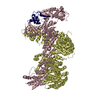 7z8rC  7z8tC 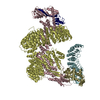 7z8vC 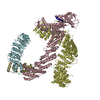 7zbwC 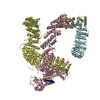 8cdjC 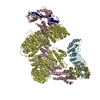 8cdkC M: map data used to model this data C: citing same article ( |
|---|---|
| Similar structure data | Similarity search - Function & homology  F&H Search F&H Search |
- Links
Links
- Assembly
Assembly
| Deposited unit | 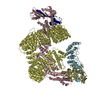
|
|---|---|
| 1 |
|
- Components
Components
-Protein , 3 types, 3 molecules CDR
| #1: Protein | Mass: 89800.367 Da / Num. of mol.: 1 Source method: isolated from a genetically manipulated source Source: (gene. exp.)  Homo sapiens (human) / Gene: CUL1 / Production host: Homo sapiens (human) / Gene: CUL1 / Production host:  Trichoplusia ni (cabbage looper) / References: UniProt: Q13616 Trichoplusia ni (cabbage looper) / References: UniProt: Q13616 |
|---|---|
| #2: Protein | Mass: 137314.156 Da / Num. of mol.: 1 Source method: isolated from a genetically manipulated source Source: (gene. exp.)  Homo sapiens (human) / Gene: CAND1, KIAA0829, TIP120, TIP120A / Production host: Homo sapiens (human) / Gene: CAND1, KIAA0829, TIP120, TIP120A / Production host:  |
| #3: Protein | Mass: 12089.677 Da / Num. of mol.: 1 Source method: isolated from a genetically manipulated source Source: (gene. exp.)  Homo sapiens (human) / Gene: RBX1 / Production host: Homo sapiens (human) / Gene: RBX1 / Production host:  Trichoplusia ni (cabbage looper) / References: UniProt: I2CVJ6 Trichoplusia ni (cabbage looper) / References: UniProt: I2CVJ6 |
-S-phase kinase-associated protein ... , 2 types, 2 molecules SF
| #4: Protein | Mass: 18679.965 Da / Num. of mol.: 1 Source method: isolated from a genetically manipulated source Source: (gene. exp.)  Homo sapiens (human) / Gene: SKP1, EMC19, OCP2, SKP1A, TCEB1L / Production host: Homo sapiens (human) / Gene: SKP1, EMC19, OCP2, SKP1A, TCEB1L / Production host:  |
|---|---|
| #5: Protein | Mass: 47961.910 Da / Num. of mol.: 1 Source method: isolated from a genetically manipulated source Details: SKP2 N-terminal region not visible in EM density. The LRR region of SKP2 was wholesale docked from previous structure with all sidechains removed. Source: (gene. exp.)  Homo sapiens (human) / Gene: SKP2, FBXL1 / Production host: Homo sapiens (human) / Gene: SKP2, FBXL1 / Production host:  |
-Non-polymers , 1 types, 3 molecules 
| #6: Chemical |
|---|
-Details
| Has ligand of interest | Y |
|---|---|
| Has protein modification | N |
-Experimental details
-Experiment
| Experiment | Method: ELECTRON MICROSCOPY |
|---|---|
| EM experiment | Aggregation state: PARTICLE / 3D reconstruction method: single particle reconstruction |
- Sample preparation
Sample preparation
| Component |
| ||||||||||||||||||||||||
|---|---|---|---|---|---|---|---|---|---|---|---|---|---|---|---|---|---|---|---|---|---|---|---|---|---|
| Source (natural) |
| ||||||||||||||||||||||||
| Source (recombinant) |
| ||||||||||||||||||||||||
| Buffer solution | pH: 7.5 | ||||||||||||||||||||||||
| Specimen | Conc.: 2 mg/ml / Embedding applied: NO / Shadowing applied: NO / Staining applied: NO / Vitrification applied: YES | ||||||||||||||||||||||||
| Vitrification | Cryogen name: ETHANE |
- Electron microscopy imaging
Electron microscopy imaging
| Experimental equipment |  Model: Titan Krios / Image courtesy: FEI Company |
|---|---|
| Microscopy | Model: FEI TITAN KRIOS |
| Electron gun | Electron source:  FIELD EMISSION GUN / Accelerating voltage: 300 kV / Illumination mode: FLOOD BEAM FIELD EMISSION GUN / Accelerating voltage: 300 kV / Illumination mode: FLOOD BEAM |
| Electron lens | Mode: BRIGHT FIELD / Nominal defocus max: 2000 nm / Nominal defocus min: 500 nm |
| Image recording | Electron dose: 68 e/Å2 / Film or detector model: GATAN K3 BIOQUANTUM (6k x 4k) |
- Processing
Processing
| Software | Name: PHENIX / Version: 1.19.2_4158: / Classification: refinement | ||||||||||||||||||||||||
|---|---|---|---|---|---|---|---|---|---|---|---|---|---|---|---|---|---|---|---|---|---|---|---|---|---|
| EM software | Name: PHENIX / Category: model refinement | ||||||||||||||||||||||||
| CTF correction | Type: PHASE FLIPPING AND AMPLITUDE CORRECTION | ||||||||||||||||||||||||
| 3D reconstruction | Resolution: 3.1 Å / Resolution method: FSC 0.143 CUT-OFF / Num. of particles: 196974 / Symmetry type: POINT | ||||||||||||||||||||||||
| Refine LS restraints |
|
 Movie
Movie Controller
Controller



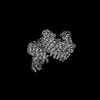













































 PDBj
PDBj












